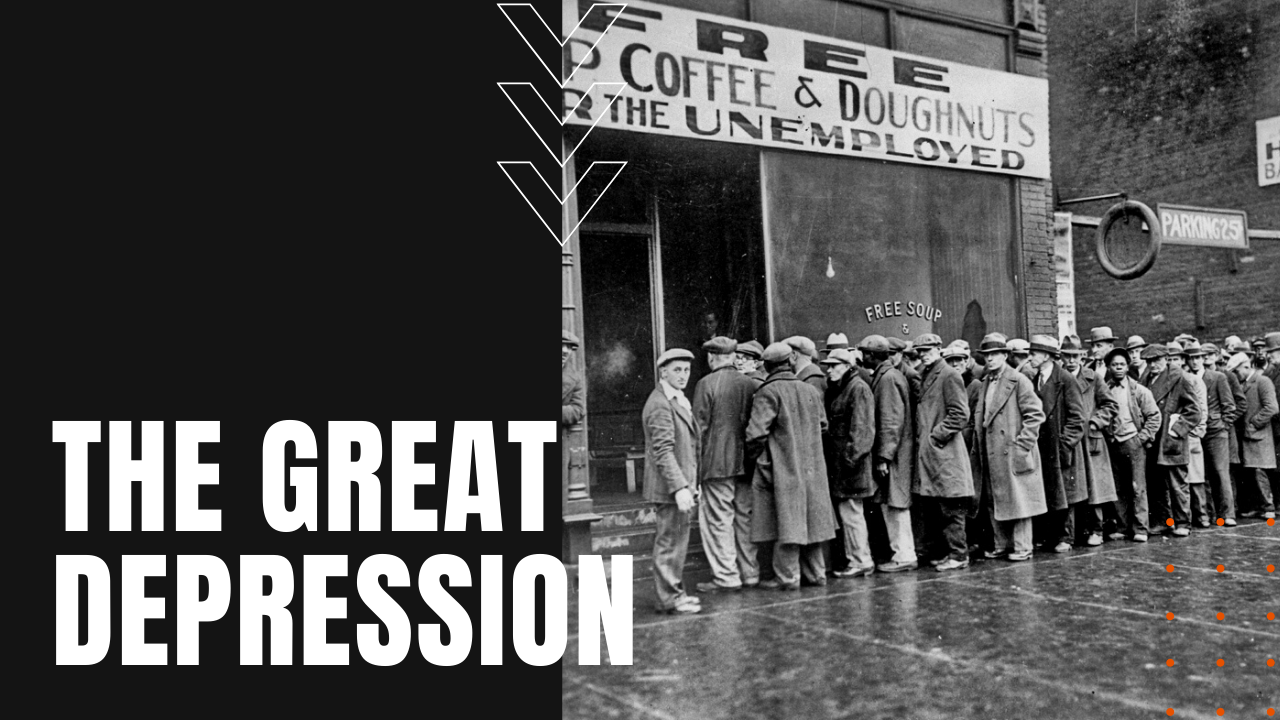The Great Depression

Throughout the Roaring Twenties, the U.S. economy nearly doubled its wealth, leading to reckless over-speculation on Wall Street, which reached its peak by August of 1929.
How Did The Great Depression Start?
Combined with declining industrial output, rising unemployment, a widespread drought in multiple farming regions and a banking sector bloated with questionable loans, conditions morphed into a perfect storm that exploded on Wall Street on October 24th, 1929. Known at “Black Thursday,” panicked investors sold off a record 12.9 million shares, followed five days later by the “Black Tuesday” selloff of an additional 16 million shares, wiping out millions of individual fortunes while setting the stage for widespread bank failures as their individual solvency grew challenged by loan defaults.
What Was The Great Depression?
As consumer confidence eroded in the wake of Wall Street’s collapse, a decrease in industrial production led to even high unemployment, lower wages and decreased consumer buying power. By 1931, the nation’s industrial production had dropped by half, and as bread lines and soup kitchens formed in cities across the nation, so did the growing number of homeless people, as well as a Dust Bowl in the Southern Plains, that prompted additional mass migrations of destitute farmers seeking employment in cities.
By its peak in 1933, the Great Depression witnessed a national unemployment rate of 20%, while thousands of regional banks had closed their doors for good. Known as a laissez-faire Republican, President Herbert Hoover’s failure to intervene on an ailing economy led to the naming of homeless encampments as Hoovervilles, as well as a landslide victory for presidential candidate Franklin D. Roosevelt in the election of 1932, who famously encouraged downtrodden Americans that “the only thing we have to fear is fear itself.”
FDR Seeks Reform and Investment in America
FDR’s fireside chats soon projected optimism and calm over a jittery nation, which he turned into action with his New Deal policies, including the Tennessee Valley Authority and the Works Progress Administration that gave government-funded infrastructure employment to 8.5 million Americans from 1935 to 1943.
He also sought reforms in the financial sector, including the Federal Deposit Insurance Corporation or FDIC, which protected individual bank accounts with government-backed assurances, and the Securities and Exchange Commission or SEC, which applied regulation and oversight on all stock and commodity markets intended to prevent the kinds of abuses that led to the stock market crash of 1929.
While early signs of recovery became measurable in the spring of 1933, a sharp downturn occurred four years later, largely inspired by the Federal Reserve’s decision to increase its requirements for money held in federal coffers, in turn creating a contraction that zeroed out most of the gains witnessed since 1933.
The Global Depression
Nor were depression-era hardships limited to America, which helped to fuel the rise of extremist political movements in Europe, including Adolf Hitler’s ascension to power in 1933 Germany. Following Hitler’s invasion of Poland in 1939, the WPA switched its emphasis to strengthening American military infrastructure, followed by a massive increase in defense manufacturing after FDR’s decision to support Britain and France in their struggle against Nazi aggression.
How Long Did The Great Depression Last?
While most historians place the end of the Great Depression in 1939, or 10 years in duration, the true economic turnaround occurred in 1941, after the U.S. entered World War Two following the Japanese attack on Pearl Harbor, making The Great Depression one of the worst 10-12 years in American history.
